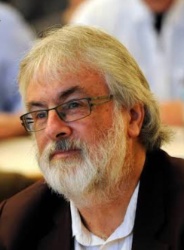Medium Rare: The Murder Of Dr. David Kelly
The Murder Of Dr. David Kelly
Part One of Two
Medium Rare - By Jim Rarey
October 14th 2003
(This first part lays out the case from the evidence presented in the Hutton inquiry why the death of Dr. David Kelly was not by suicide. Part two will show the reasons, in this writer's opinion, Dr. Kelly was killed.)
On Thursday, July 17th sometime between 3 and 3:30pm, Dr. David Kelly started out on his usual afternoon walk. About 18 hours later, searchers found his body, left wrist slit, in a secluded lane on Harrowdown Hill. Kelly, the UK's premier microbiologist, was in the center of a political maelstrom having been identified as the 'leak' in information about the 'dossier' Prime Minister Tony Blair had used to justify the war against Iraq.
While the Hutton inquiry appears set to declare Kelly's death a suicide and the national media are already treating it as a given, there are numerous red flags raised in the testimony and evidence at the inquiry itself.
Kelly's body was likely moved from where he died to the site where two search volunteers with a search dog found it. The body was propped up against a tree according to the testimony of both volunteers. The volunteers reported the find to police headquarters, Thames Valley Police (TVP) and then left the scene. On their way back to their car, they met three 'police' officers, one of them named Detective Constable Graham Peter Coe.
Coe and his men were alone at the site for 25-30 minutes before the first police actually assigned to search the area arrived (Police Constables Sawyer and Franklin) and took charge of the scene from Coe. They found the body flat on its back a short distance from the tree, as did all subsequent witnesses.
A logical explanation is that Dr. Kelly died at a different site and the body was transported to the place it was found. This is buttressed by the medical findings of livor mortis (post mortem lividity), which indicates that Kelly died on his back, or at least was moved to that position shortly after his death. Propping the body against the tree was a mistake that had to be rectified.
The search dog and its handler must have interrupted whoever was assigned to go back and move the body to its back before it was done. After the volunteers left the scene the body was moved to its back while DC Coe was at the scene.
Five witnesses said in their testimony that two men accompanied Coe. Yet, in his testimony, Coe maintained there was only one other beside himself. He was not questioned about the discrepancy.
Researchers, including this writer, assume the presence of the 'third man' could not be satisfactorily explained and so was being denied.
Additionally, Coe's explanation of why he was in the area is unsubstantiated. To the contrary, when PC Franklin was asked if Coe was part of the search team he responded, 'No. He was at the scene. I had no idea what he was doing there or why he was there. He was just at the scene when PC Sawyer and I arrived.'
Franklin was responsible for coordinating the search with the chief investigating officer and then turning it over to Sawyer to assemble the search team and take them to the assigned area. They were just starting to leave the station (about 9am on the 18th) to be the first search team on the ground (excepting the volunteers with the search dog) when they got word the body had been found.
A second red flag is the nature of the wounds on Kelly's wrist. Dr. Nicholas Hunt, who performed the autopsy, testified there were several superficial 'scratches' or cuts on the wrist and one deep wound that severed the ulnar artery but not the radial artery.
The fact that the ulnar artery was severed, but not the radial artery, strongly suggests that the knife wound was inflicted drawing the blade from the inside of the wrist (the little finger side closest to the body) to the outside where the radial artery is located much closer to the surface of the skin than is the ulnar artery. For those familiar with first aid, the radial artery is the one used to determine the pulse rate.
Just hold your left arm out with the palm up and see how difficult it would be to slash across the wrist avoiding the radial artery while severing the ulnar artery. However, a second person situated to the left of Kelly who held or picked up the arm and slashed across the wrist would start on the inside of the wrist severing the ulnar artery first.
A reasonably competent medical examiner or forensic pathologist would certainly be able to determine in which direction the knife was drawn across the wrist. That question was never asked nor the answer volunteered. In fact, a complete autopsy report would state in which direction the wounds were inflicted. The coroner's inquest was never completed as it was preempted by the Hutton inquiry and the autopsy report will not be made public. Neither will the toxicology report.
Two paramedics who arrived by ambulance at the same time as Franklin and Sawyer (some time after 9am) and accompanied them to where the body was located. After checking the eyes and signs of a pulse or breathing, they attached four electro-cardiogram pads to Kelly's chest and hooked them up to a portable electro-cardiograph. When no signs of heart activity were found they unofficially confirmed death. One paramedic (Vanessa Hunt) said the Police asked them to leave the pads on the body. The other paramedic (David Bartlett) said they always left the pads on the body.
Both paramedics testified that DC Coe had two men with him. Curiously, both also volunteered that there was a surprisingly small amount of blood at the scene for an artery having been severed.
When the forensic pathologist (Dr. Nicholas Hunt) who performed the autopsy testified, he described copious amounts of blood at the scene. He also described scratches and bruises that Kelly 'stumbling around' in the heavy underbrush may have caused. He said there was no indication of a struggle or Kelly having been forcibly restrained.
However, the police made an extensive search of the area and found no indication of anyone, including Kelly, having been in the heavy underbrush.
Strangely, none of the witnesses mentioned anything about rigor mortis (stiffening of the body) which is useful in setting the approximate time of death. Even Dr. Hunt, when was asked directly what changes on the body he observed that would have happened after death, failed to mention rigor mortis. He only named livor mortis. Hunt set the time of death within a range of 4:15pm on the 17th to 1:15am the next morning. He based the estimate on body temperature which he did not take until 7:15pm on the 19th, some seven hours after he arrived on the scene.
A forensic biologist (Roy James Green) had been asked to examine the scene. He said the amount of blood he saw was consistent with a severed artery. Green works for the same private company (Forensic Alliance) as Dr. Hunt. A majority of the company's work is done for police organizations.
The afternoon of the 18th DC Coe turned up at the Kelly residence accompanied by a man identified only as 'an attachment,' who acted as an 'exhibits officer' presumably collecting documents in behalf of some other government agency.
Detective Constable Coe and those accompanying him are somewhat of a mystery. There are no corroborating witnesses to any of his actions to which he testified (other than 'just being there' at the scene where the body was found).
However, on a listing of evidence provided to the Hutton inquiry by Thames Valley Police is a reference to a document described thusly, 'TVP Tactical Support Major Incident Policy Book·Between 1430 17.07.03 and 930 18.07.03. DCI Alan Young. It is labeled ãnot for release - Police operational information.' Many of the exhibits are labeled that way or are not to be released as personal information.
The police took over 300 statements from witnesses but less than 70 were forwarded to the Hutton inquiry. Witness statements were not to be released (even to the inquiry) unless the witness signed an authorization permitting it. TVP also withheld witness interviews they did not consider 'relevant' to the inquiry. Witnesses were not put under oath so it is impossible for the public to know if their public statements are at variance with what they told police. The 'tactical support' document must have been considered relevant to the inquiry on Kelly's death or it wouldn't have been forwarded.
So this 'tactical support' began at 2:30pm on the 17th, about one hour before Dr. Kelly left the house on his final walk. It ended at 9:30am the following morning about the time DC Coe and his men left the death scene. The obvious question is, to what was TVP giving tactical support? The name given the effort was 'Operation Mason.'
(In part two of this report, we will lay out some of the reasons - that you won't see in the national media - Dr. Kelly could not be allowed to live.)
© Permission is granted to reproduce this article in its entirety.
The author is a freelance writer based in Romulus, Michigan. He is a former newspaper editor and investigative reporter, a retired customs administrator and accountant, and a student of history and the U.S. Constitution. If you would like to receive Medium Rare articles directly, please contact the author at jimrarey@comcast.net
RELATED LINKS.... EARLIER SCOOP HUTTON INQUIRY COVERAGE...
Streets Of London: The
Hutton Inquiry - In the Inquiry today no witnesses were
called. It was the day for the closing statements from legal
Counsel. The star of the day's proceedings, as he had been
since the Inquiry resumed, was Jeremy Gompertz QC, counsel
for the Kelly Family. See... Streets Of London: Hutton Inq. Closing Statements
MORE:
Hutton
Inquiry Update - Day 22 - Day
21 - Day 20 - Day 19 - Day
18 - Day
17
- Streets Of London: Hutton Inquiry Resumed
Streets
Of London: Tony Blair At The Hutton Inquiry - Scoop's
London Correspondent William Moloney is filing blow by blow
coverage from the Hutton inquiry. See... SOL: Hutton Inquiry Update - Week 4 Day 1 and SOL: Hutton Inquiry - Monday 15th September
SCOOP HUTTON INQUIRY
COVERAGE
SOL WEEK THREE: PM Tony Blair's Evidence - Week 3 Day 2 - Week
3 Day 1
SOL WEEK TWO: Week
2 Day 4 - Week 2 Day 3 - Week
2 Day 2 - Week 2 Day 1
SOL WEEK ONE:
Streets Of London: Looking the Other Way
COMMENTARY:
- Dennis Hans - Passive Deceit & the Death of David Kelly
- Dennis
Hans - African Uranium, The Scarlett Dossier
- Dennis Hans
- British Intelligence Is an Oxymoron
LINK: INQUIRY REVEALS CAMPBELL ORDERED DOSSIER
REWRITE -
SCOTSMAN


 Martin LeFevre - Meditations: In A Global Society, There Is No Such Thing As “National Security”
Martin LeFevre - Meditations: In A Global Society, There Is No Such Thing As “National Security” Binoy Kampmark: Secrecy And Virtue Signalling - Another View Of Signalgate
Binoy Kampmark: Secrecy And Virtue Signalling - Another View Of Signalgate Gordon Campbell: On The Americanising Of NZ’s Public Health System
Gordon Campbell: On The Americanising Of NZ’s Public Health System Ian Powell: Trumpian Health Leadership
Ian Powell: Trumpian Health Leadership Eugene Doyle: Disruption - Historians Challenge Russophobic Propaganda
Eugene Doyle: Disruption - Historians Challenge Russophobic Propaganda Ramzy Baroud: War, Doublethink, And The Struggle For Survival - Geopolitics Of The Gaza Genocide
Ramzy Baroud: War, Doublethink, And The Struggle For Survival - Geopolitics Of The Gaza Genocide